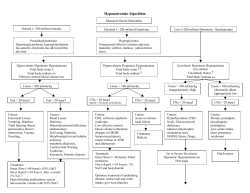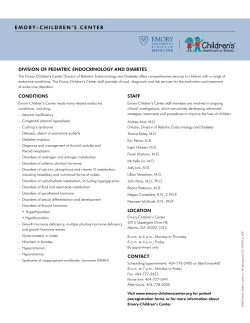
hyponatremia treatment guidelines: 2012 and beyond
Diabetes Insipidus and SIADH Joseph G. Verbalis, MD Clinical Endocrinology: 2007 hyponatremia treatment guidelines: 2012 and beyond Joseph G. Verbalis, MD Professor of Medicine and Physiology Chief, Endocrinology and Metabolism Director, Georgetown-Howard Universities Center for Clinical and Translational Science Georgetown University Washington, DC USA Joseph G. Verbalis: disclosures consultant: Astellas, Ferring, Cardiokine, Otsuka advisory board: Astellas, Otsuka data safety board: Ferring grant support: NHLBI, NIA, NCATS, Otsuka 1 Diabetes Insipidus and SIADH Joseph G. Verbalis, MD Clinical Endocrinology: 2007 body fluid compartments water is the largest component of our body; since the major determinant of body water is AVP-regulated water excretion by the kidneys, it follows logically that AVP must be the most important hormone in the body AVP stimulation and effects hyperosmolality, hypovolemia, angiotensin II + – baroreceptors, natriuretic peptides AVP V1a Receptors vasoconstriction V2 Receptors renal H2O reabsorption 2 Diabetes Insipidus and SIADH Joseph G. Verbalis, MD Clinical Endocrinology: 2007 receptor-mediated effects of AVP receptor subtype site of action vascular smooth muscle cells platelets V1a lymphocytes and monocytes liver activation effects vasoconstriction platelet aggregation cytokine release glycogenolysis V1b anterior pituitary ACTH and β -endorphin release V2 renal collecting duct principal cells free water absorption AVP Collecting Duct Cell AQP3 H2O ATP GTP (Gs) AVP V2 Receptor AQP2 cAMP Exocytic Insertion PKA AQP2 AQP4 Basolateral membrane Recycling vesicle Collecting duct Vasa recta AVP regulation of water reabsorption from renal tubular cells H2O Endocytic Retrieval Luminal membrane 3 Diabetes Insipidus and SIADH Joseph G. Verbalis, MD Clinical Endocrinology: 2007 prevalence of dysnatremias at initial presentation to a health care provider (data from 303,577 samples on 120,137 patients available for analysis) 30 Acute hospital care Ambulatory hospital care Community care 28.2 Prevalence (%) 25 21 20 15 10 7.2 5 0 1.43 0.49 0.17 0.03 Na < 116 Na < 135 0.53 0.72 0.06 0.01 0.01 Na > 145 Na > 165 Hawkins. Clin Chim Acta 337:169-172, 2003 relationship between hospital admission serum [Na+] and in-hospital mortality Predicted Probability of In-Hospital Mortality 0.20 0.15 0.10 0.05 110 115 120 125 130 135 140 145 Admission Serum [Na+] Concentration (mEq/L) Wald et al. Arch Intern Med 170:294-302, 2010 4 Diabetes Insipidus and SIADH Joseph G. Verbalis, MD Clinical Endocrinology: 2007 chronic hyponatremia is also associated with increased adverse outcomes increased mortality over a 12-year period of outpatient follow-up significantly increased risk of fracture Hoorn et al. J Bone Mineral Res 26:1822-8, 2011 hyponatremic disorders hypovolemia/dehydration polydipsia SIADH extracellular fluid volume expansion congestive heart failure hepatic cirrhosis bilateral ureteral obstruction 5 Diabetes Insipidus and SIADH Joseph G. Verbalis, MD Clinical Endocrinology: 2007 hyponatremia can be caused by dilution from retained water, or by depletion from electrolyte losses in excess of water 6 Diabetes Insipidus and SIADH Joseph G. Verbalis, MD Clinical Endocrinology: 2007 U-Na+ excretion for identification of EABV with diuretics without diuretics Fenske W. et al, JCEM 92:2991- 2997, 2008 SIADH: essential criteria • • true plasma hypoosmolality • • clinical euvolemia, no diuretic therapy • normal thyroid, adrenal and renal function urine concentration inappropriate for plasma osmolality (Uosm > 100 mOsm/kg H2O) absent renal sodium conservation (UNa > 30 mmol/L) modified from Bartter & Schwartz, Am J Med 42:790-806, 1967 7 Diabetes Insipidus and SIADH Joseph G. Verbalis, MD Clinical Endocrinology: 2007 Plasma Vasopressin, pg/mL plasma AVP levels are inappropriately elevated in >95% of patients with SIADH 11 10 9 8 7 6 5 4 3 2 1 0 Normal Range 230 240 250 260 270 280 290 300 Plasma Osmolality, mOsm/kg H2O 310 Robertson et al. Am J Med 72:339, 1982 stimuli to AVP secretion related to fluid independent of homeostasis: fluid homeostasis: hyperosmolality nausea hypotension hypoxia hypovolemia hypercarbia angiotensin II hypoglycemia stress: cytokines physical activity 8 Diabetes Insipidus and SIADH Joseph G. Verbalis, MD Clinical Endocrinology: 2007 plasma osmolality (mOsm/kg H2O) 296 thirst osmotic threshold plasma AVP (pg/ml) 9 294 8 292 7 290 6 5 288 286 4 urine osmolality (mOsm/kg H2O) 1000 800 250 500 3 600 AVP osmotic threshold maximal urine excretion rate (ml/h) 284 2 282 1 300 280 0 100 400 1000 200 0 278 0 250 500 750 1000 Urine volume (ml/h) 276 nephrogenic SIAD caused by an activating mutation of the AVP V2R at the same site that also can cause DI via an inactivating mutation Feldman et al. New Engl J Med 352:1884-90, 2005 9 Diabetes Insipidus and SIADH Joseph G. Verbalis, MD Clinical Endocrinology: 2007 acute hyponatremia is associated with high morbidity and mortality acute patients duration serum [Na+] stupor or coma seizures mortality low [Na+] deaths 14 < 12 hrs 112 ± 2 100% 29% 50% 36% chronic 52 3 days 118 ± 1 6% 4% 6% 0% Arieff et al. Medicine 56:121, 1976 (hospital consults in one year; [Na+]<128 mmol/L) 10 Diabetes Insipidus and SIADH Joseph G. Verbalis, MD Clinical Endocrinology: 2007 acute hyponatremia can cause death from cerebral edema and brain herniation normal brain hyponatremic brain London marathon, April 22, 2007 “A 22-year-old man died after completing his first London Marathon because he drank too much water. David Rogers collapsed at the end of the race and died yesterday in Charing Cross Hospital.” “Today it emerged the fitness instructor from Milton Keynes died from hyponatraemia, or water intoxication. This is when there is so much water in the body that it dilutes vital minerals such as sodium down to dangerous levels. It can lead to confusion, headaches and a fatal swelling of the brain.” p[Na+] = 122 mmol/L drank Lucozade http://www.dailymail.co.uk/news/article450341/Marathon-victim-died-drinking-MUCH-water.html 11 Diabetes Insipidus and SIADH Joseph G. Verbalis, MD Clinical Endocrinology: 2007 chronic hyponatremia is associated with much less severe symptomatology acute patients duration serum [Na+] stupor or coma seizures mortality low [Na+] deaths 14 < 12 hrs 112 ± 2 100% 29% 50% 36% chronic 52 3 days 118 ± 1 6% 4% 6% 0% Arieff et al. Medicine 56:121, 1976 (hospital consults in one year; [Na+]<128 mmol/L) brain volume regulation 1. true loss of brain solute 2. can reduce or eliminate brain edema despite severe hypoosmolality 3. time dependent process Gullans & Verbalis Ann Rev Med 44:289-301, 1993 THIS IS NOT A NORMAL BRAIN! 12 Diabetes Insipidus and SIADH Joseph G. Verbalis, MD Clinical Endocrinology: 2007 symptomatic hyponatremia: neurological manifestations • • • • • • • headache irritability nausea / vomiting mental slowing unstable gait / falls confusion / delerium disorientation • • • stupor / coma convulsions respiratory arrest symptomatic but less impaired; usually chronic the degree of symptomatology is a surrogate for the duration of hyponatraemia life-threatening; usually acute pontine and extrapontine myelinolysis: clinical manifestations • • • • • • • tremor incontinence hyperreflexia, pathological reflexes quadriparesis, quadriplegia dysarthria, dysphagia cranial nerve palsies mutism, locked-in syndrome 13 Diabetes Insipidus and SIADH Joseph G. Verbalis, MD Clinical Endocrinology: 2007 central pontine myelinolysis: white areas in the middle of the pons indicate massive demyelination of descending axons (corticobulbar and corticospinal tracts) Wright, Laureno & Victor Brain 102:361-385, 1979 safe correction of hyponatremia entails balancing the risks of the hyponatremia versus the risks of the correction; these, in turn, depend on the degree of brain volume regulation that has occurred Verbalis Trends Endocrinol Metab 3:1-7, 1992 14 Diabetes Insipidus and SIADH Joseph G. Verbalis, MD Clinical Endocrinology: 2007 managing the rate of correction of hyponatremia 1. maximum correction for chronic hyponatremia: ≤12 mmol/L in the first 24 h ≤18 mmol/L in the first 48 h 2. even lower (≤8 mmol/L in any 24h period) if any of the following are present: • serum Na ≤105 mEq/L • hypokalemia • alcoholism and/or malnutrition • liver disease 3. maximum correction for acute hyponatremia: not ascertained, but much lower risk treatments for hyponatremia isotonic saline infusion hypertonic saline infusion vaptan (conivaptan, tolvaptan) short-term fluid restriction demeclocycline furosemide + NaCl mineralocorticoids urea vaptan (tolvaptan) long-term 15 Diabetes Insipidus and SIADH Joseph G. Verbalis, MD Clinical Endocrinology: 2007 hypertonic saline correction • choose desired correction rate of plasma [Na+] (e.g., 1.0 mEq/L/h) • obtain or estimate patient’s weight (e.g., 70 kg) • multiply weight X desired correction rate and infuse as ml/h of 3% NaCl (e.g., 70 kg X 1.0 mEq/L/h = 70 ml/h infusion) 16 Diabetes Insipidus and SIADH Joseph G. Verbalis, MD Clinical Endocrinology: 2007 X Nielsen et al., JASN 10:647-663, 1999 17 Diabetes Insipidus and SIADH Joseph G. Verbalis, MD Clinical Endocrinology: 2007 diuresis: increased excretion of urine by the kidney; includes water and typically increased solute excretion as well aquaresis: increased excretion of water by the kidney without increased solute, i.e., electrolyte-sparing excretion of free water by the kidney what aquaresis really looks like! courtesy nephology fellows, Lenox Hill Hospital, New York, NY 18 Diabetes Insipidus and SIADH Joseph G. Verbalis, MD Clinical Endocrinology: 2007 tolvaptan: SALT studies and SALT-WATER open label extension study Berl et al. J Am Soc Nephrol 4:705-712, 2010 Delta increase in serum Sodium (mmol/L) SALT: mean increases in serum [Na+] after 30 d in patients with cirrhosis, HF, and SIADH 8 7 6 5 4 Control Tolvaptan * * *P<.05 * 3 2 1 0 cirrhosis HF SIADH Schrier et al. NEJM 355:2099-2112, 2006 19 Diabetes Insipidus and SIADH Joseph G. Verbalis, MD Clinical Endocrinology: 2007 tolvaptan: SALT trials, SIADH patients changes in SF-12 general health survey scores after 30 days of oral administration 7.5 placebo (n=39) tolvaptan (n=41) p=0.051 5.47 p=0.019 5 3.64 2.5 -0.16 -0.45 0 Physical Component Score Mental Component Score (physical function, body pain, general health, physically limited accomplishment) (vitality, social function, calmness, sadness, emotionally limited accomplishment) Verbalis et al. Eur J Endocrinol 164:725–732, 2011 treatment of hyponatremia results in an improvement of the MCS to the mean of average U.S. adults Depression Cutpoint hyponat before rx hyponat after rx Adult Median Adult Mean treatment 30 35 40 45 50 55 SF-12 Mental Component Summary (MCS) 20 Diabetes Insipidus and SIADH Joseph G. Verbalis, MD Clinical Endocrinology: 2007 fluid restriction general guidelines: • • • restrict all intake that is consumed by drinking, not just water aim for a fluid restriction that is 500 ml/d below the 24-hour urine output do not restrict sodium unless indicated predictors of failure of fluid restriction: • • • • high urine osmolality (>500 mOsm/kg H2O) urine Na+ + K+ greater than the serum [Na+] 24-hour urine output <1,500 ml/d increase in serum [Na+] <2 mmol/L in 24h 21 Diabetes Insipidus and SIADH Joseph G. Verbalis, MD Clinical Endocrinology: 2007 approach to raising plasma osmolality by fluid restriction urine/plasma electrolyte ratio recommended fluid consumption >1.0 0 mL 0.5–1.0 Up to 500 mL <0.50 Up to 1 L Furst H et al. Am J Med Sci 319:240-244, 2000 hyponatremia treatment algorithm euvolemic hyponatremia (SIADH) LEVEL 3 – SEVERE SYMPTOMS: vomiting, seizures, obtundation, respiratory distress, coma hypertonic NaCl , followed by fluid restriction ± vaptan LEVEL 2 – MODERATE SYMPTOMS: nausea, confusion, disorientation, altered mental status vaptan, followed by fluid restriction 22 Diabetes Insipidus and SIADH Joseph G. Verbalis, MD Clinical Endocrinology: 2007 osmotic demyelination syndrome (ODS) no cases of CPM have been reported following correction of hyponatremia with vaptans in >5,000 patients to date Wright, Laureno & Victor Brain 102:361-385, 1979 hyponatremia treatment algorithm euvolemic hyponatremia (SIADH) LEVEL 3 – SEVERE SYMPTOMS: vomiting, seizures, obtundation, respiratory distress, coma hypertonic NaCl , followed by fluid restriction ± vaptan LEVEL 2 – MODERATE SYMPTOMS: nausea, confusion, disorientation, altered mental status vaptan, followed by fluid restriction fluid restriction, but vaptan under select circumstances: • inability to tolerate fluid restriction or failure of fluid restriction LEVEL 1 – NO OR MINIMAL SYMPTOMS: headache, irritability, inability to concentrate, altered mood, depression • unstable gait and/or high fracture risk • very low sodium level (<125 mEq/L) with • • • increased risk of developing symptomatic hyponatremia need to correct serum [Na+] to safer levels for surgery or procedures, or for ICU/hospital discharge prevention of worsened hyponatremia with increased fluid administration therapeutic trial for symptom relief 23 Diabetes Insipidus and SIADH Joseph G. Verbalis, MD Clinical Endocrinology: 2007 hyponatremia increased the risk of fracture in CKD independently of osteoporosis 4.50 95% Confidence Interval 4.00 1,408 female patients from Cork, Ireland adjusted for age, T-score, amenorrhea, steroid use, liver disease, smoking and EtOH use, liver disease, and osteoporosis treatments 3.50 3.00 2.50 2.00 1.50 1.00 0.50 0.00 <135 136–137 138–140 141–142 143–145 >145 Serum Sodium (mmol/L) Kinsella et al. Clin J Am Soc Nephrol 5:275-280, 2010 correction of hyponatremia normalizes gait stability in “asymptomatic” hyponatremia serum [Na+] = 130 mEq/L -500 -400 -300 -200 80 60 40 20 0 -100 -20 -40 -60 -80 -100 -120 -100 serum [Na+] = 139 mEq/L -200 -500 serum [Na+] = 124 mEq/L -500 -400 -300 -200 140 120 100 80 60 40 20 0 -20 -100 0 -40 -60 -80 -100 -120 -100 -400 -300 -200 80 60 40 20 0 -100 -20 -40 -60 -80 -100 -120 100 200 200 serum [Na+] = 135 mEq/L -200 -400 -300 -200 100 80 60 40 20 0 -100 -20 -40 -60 -80 -100 -120 100 200 200 Renneboog et al. Am J Med 119:71, 2006 24 Diabetes Insipidus and SIADH Joseph G. Verbalis, MD Clinical Endocrinology: 2007 increased risk of falls with “asymptomatic” hyponatremia Group n “asymptomatic” chronic hyponatremia 122 normonatremic controls 244 % Falls 21.3% 5.35% Odds ratio Adjusted odds ratio* 9.45 67.43 (2.64–34.09) (7.48–607.42) p<0.001 p<0.001 1.00 1.00 *adjusted for age, sex and covariates Renneboog et al. Am J Med 119:71, 2006 hyponatremia induces marked bone loss in rats normonatremic [Na+] = 140 hyponatremic [Na+] = 115 Verbalis, Barsony, et al. JBMR 25:554-663, 2010 25 Diabetes Insipidus and SIADH Joseph G. Verbalis, MD Clinical Endocrinology: 2007 hyponatremia induces a 5-fold increase in osteoclasts compared to normonatremic controls by TRAP staining * TRAP + MNC/area 20 normonatremic 15 10 5 hyponatremic 0 Solid + dDAVP Liquid + dDAVP Verbalis, Barsony, et al. JBMR 25:554-663, 2010 odds ratio for hyponatremia as a predictor of osteoporosis in NHANES III database odds ratio (95% CI) 100.0 10.0 7.66 2.85 1.0 1.03 0.1 total hip (p=0.043) 5.81 2.87 1.41 femoral neck p<0.003) bone mineral density by of hip measured by DEXA; results adjusted for age, sex, BMI, physical activity, serum vitamin D (ng/mL) and diuretic use mean serum [Na+] = 133.0 ± 0.2 mmol/L Verbalis, Barsony, et al. JBMR 25:554-663, 2010 26 Diabetes Insipidus and SIADH Joseph G. Verbalis, MD Clinical Endocrinology: 2007 why does hyponatremia cause osteoporosis??? one-third of total body sodium is stored in bone, and mobilization of this sodium from bone during prolonged deprivation requires the resorption of bone matrix, similar to the release of stored calcium to compensate for calcium deprivation Bergstrom & Wallace. Bone as a sodium and potassium reservoir. J Clin Invest 33:867-873, 1954. Edelman, James, Baden & Moore. Electrolyte composition of bone and the penetration of radiosodium and deuterium oxide into dog and human bone. J Clin Invest 33:122-131, 1954. hyponatremia-induced activation of ROS pathways in serum and in osteoclasts differentiated from RAW264.7 cells Barsony et al. JBC 286(12):10864-75, 2011 27 Diabetes Insipidus and SIADH Joseph G. Verbalis, MD Clinical Endocrinology: 2007 1. osteoporosis 2. hypogonadism 3. cardiac fibrosis 4. sarcopenia 5. decreased body fat Barsony et al. AGE, Jan 5 2012 [Epub ahead of print] 28 Diabetes Insipidus and SIADH Joseph G. Verbalis, MD Clinical Endocrinology: 2007 Barsony et al. AGE, Jan 5 2012 [Epub ahead of print] evidence-based medicine the Japanese eat a low fat diet and have lower rates of cardiovascular disease than the English and Americans the French eat a high fat diet and have lower rates of cardiovascular disease than the English and Americans the Chinese drink little alcohol and have lower rates of cardiovascular disease than the English and Americans the Italians drink much alcohol and have lower rates of cardiovascular disease than the English and Americans evidence-based conclusions? eat and drink whatever you want it’s speaking English that kills you courtesy of Dr. Peter Liu, University of Toronto 29 Diabetes Insipidus and SIADH Joseph G. Verbalis, MD Clinical Endocrinology: 2007 tolvaptan: need to continue therapy after discharge depends on the etiology of the SIADH 30
© Copyright 2025


















